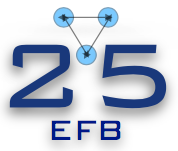Speaker
Description
We applied a many-configurational microscopic cluster model to study the nature of high-energy resonance states in $^{9}$Be and $^{9}$B near $^{7}$Li$+d$ and $^{7}$Be$+d$ decay thresholds and to reveal the influence of the states on the astrophysical $S$-factors of the reactions $^{7}$Li$\left( d,n\right)\alpha\alpha$ and $^{7}$Be$\left( d,p\right) \alpha\alpha$ related to the cosmological lithium problem. Parameters of the above-mentioned resonance states in $^{9}$Be and $^{9}$B were established. The dominant decay channels were determined for each resonance state.
Two coupled three-cluster configurations $\alpha+\alpha+n$ and $\alpha+d+^{3}$H in $^{9}$Be and $\alpha+\alpha+p$ and $\alpha+d+^{3}$He in $^{9}$B were considered to invoke dominant binary channels in $^{9}$Be and $^{9}$B, respectively. The model is an extension of the three-cluster model, formulated in [1], which uses Gaussian and Oscillator basis to describe the internal structure of the binary systems and their asymptotic behavior. The model suggests a realistic description of energy spectrum of $^{9}$Be and $^{9}$B in a wide range of energy, where many decay channels of the nuclei are open.
[1] V.S. Vasilevsky, F. Arickx, J. Broeckhove, and T.P. Kovalenko, Nucl. Phys. A, vol. 824, p.37, 2009.

